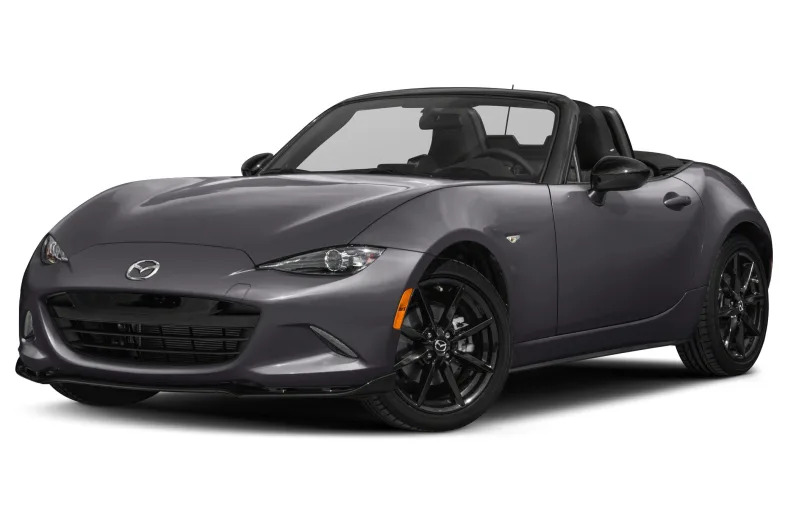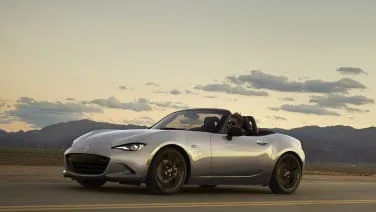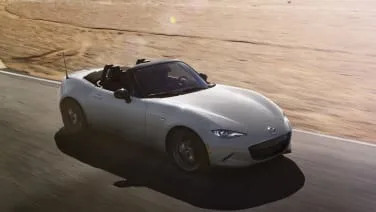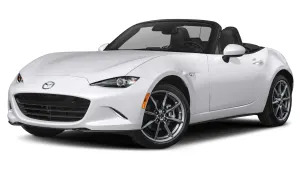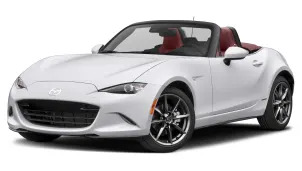Club 2dr Convertible
2020 Mazda MX-5 Miata
Full disclosure: I’m a longtime Miata fan. And by longtime I mean since mid-1989, the year I obtained, through a series of fortunate connections, one of the three original Chicago auto show display cars. But this was no blatant attempt to butter up a journalist – I barely knew how to spell the word. At the time I worked for the Department of Defense and was racing SCCA showroom stock on the side. It was destined to be a racecar. I was assured it’d be quick, but doubts surfaced when I arrived at Mazda’s dealer training center to pick it up. “Oh, it’s that cute Elan-looking thing,” I probably said. But my mind was utterly changed when I eyeballed its double-wishbone suspension and other cleverly engineered features hiding beneath its skin. In subsequent years of racing – and eventually restoring – that car, I spent uncountable hours being impressed by it. I can safely say that the new ND Miata (2016 - present) is the best yet. It’s lighter than it has been in 20 years, and that’s some trick considering the relentless march of safety requirements and expected convenience features. This car is actually 1.3 inches shorter from nose to tail than my NA Miata, but it’s also 2.4 inches wider and rolls on a wheelbase that is 1.7 inches longer. But it is the suspension that has always made the Miata great. This look under the skin of a 2020 Mazda MX-5 shows why the ND is the best Miata in that arena, too. The fact that this is an RF model doesn’t much matter one way or the other. As it was the first time I laid eyes on one, things got off to a promising start as soon as I pulled a wheel off. It’s clear that this is no mere strut suspension, as we can see a coil-over shock and glimpses of aluminum. The apparent stars of the show are the A-shaped upper wishbone (green arrow) and the L-shaped lower wishbone (white). Miatas have used this layout from Day One, but aluminum didn’t enter the picture until the NC generation. For 2020, Bilstein monotube shocks (green) come on the Club and Grand Touring models with a manual transmission. This setup was part of the GT-S option package in 2019. The standard shocks are also monotubes, but they’re not Bilsteins and they’re tuned a bit softer. The upper control arm (yellow) is mounted low down such that its ball joint (white) resides within the barrel of the front wheel. This low position increases the stresses within the arm and at its pivot points, but this car is not heavy enough to make that a consideration. It also avoids the cost and complexity of the tall and curvaceous knuckle that would be needed if this had a high-mount upper arm. Such a move would probably spoil the Miata’s low hoodline and low center of gravity because the shock towers would have to be further-strengthened, …
Full Review
Full disclosure: I’m a longtime Miata fan. And by longtime I mean since mid-1989, the year I obtained, through a series of fortunate connections, one of the three original Chicago auto show display cars. But this was no blatant attempt to butter up a journalist – I barely knew how to spell the word. At the time I worked for the Department of Defense and was racing SCCA showroom stock on the side. It was destined to be a racecar. I was assured it’d be quick, but doubts surfaced when I arrived at Mazda’s dealer training center to pick it up. “Oh, it’s that cute Elan-looking thing,” I probably said. But my mind was utterly changed when I eyeballed its double-wishbone suspension and other cleverly engineered features hiding beneath its skin. In subsequent years of racing – and eventually restoring – that car, I spent uncountable hours being impressed by it. I can safely say that the new ND Miata (2016 - present) is the best yet. It’s lighter than it has been in 20 years, and that’s some trick considering the relentless march of safety requirements and expected convenience features. This car is actually 1.3 inches shorter from nose to tail than my NA Miata, but it’s also 2.4 inches wider and rolls on a wheelbase that is 1.7 inches longer. But it is the suspension that has always made the Miata great. This look under the skin of a 2020 Mazda MX-5 shows why the ND is the best Miata in that arena, too. The fact that this is an RF model doesn’t much matter one way or the other. As it was the first time I laid eyes on one, things got off to a promising start as soon as I pulled a wheel off. It’s clear that this is no mere strut suspension, as we can see a coil-over shock and glimpses of aluminum. The apparent stars of the show are the A-shaped upper wishbone (green arrow) and the L-shaped lower wishbone (white). Miatas have used this layout from Day One, but aluminum didn’t enter the picture until the NC generation. For 2020, Bilstein monotube shocks (green) come on the Club and Grand Touring models with a manual transmission. This setup was part of the GT-S option package in 2019. The standard shocks are also monotubes, but they’re not Bilsteins and they’re tuned a bit softer. The upper control arm (yellow) is mounted low down such that its ball joint (white) resides within the barrel of the front wheel. This low position increases the stresses within the arm and at its pivot points, but this car is not heavy enough to make that a consideration. It also avoids the cost and complexity of the tall and curvaceous knuckle that would be needed if this had a high-mount upper arm. Such a move would probably spoil the Miata’s low hoodline and low center of gravity because the shock towers would have to be further-strengthened, …
Hide Full Review
Hide Full Review
Retail Price
$30,290
MSRP / Window Sticker Price
| Engine | 2.0L I-4 |
| MPG | 26 City / 34 Hwy |
| Seating | 2 Passengers |
| Transmission | 6-spd man |
| Power | 181 @ 7000 rpm |
| Drivetrain | rear-wheel |
Smart Buy Program is powered by 

